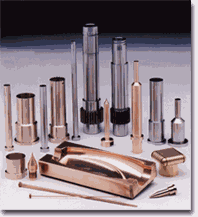
|

...World Wide Distributor of Beryllium-Free Copper Alloys...
Manufacturer of Standard & Custom Components
![]()
Site Updated Often! To ensure proper viewing please Refresh page &
MAKE SURE YOUR BROWSER IS SET TO UPDATE AT EACH VISIT
![]()
INFORMATION ABOUT HARDNESS
Copper Alloys versus Tool Steel There are a number of FACTS that need to be considered in understanding the Hardness of Copper Alloys in comparison to Tool Steels as well as other metal alloys. Precipitation Hardening Typically, Copper Alloys are "age" or precipitation hardening alloys. This means that when the alloy is manufactured, a time and temperature controlled process is performed on the product that yields the "initial hardness" of the product. An Increase in Hardness over the initial Hardness Continued heating of the Copper Alloy to temperatures, in combination with the passage of time, will further influence the hardness of copper alloys. Copper alloys that are heated to temperatures below the "final" aging temperature used during making the product, will normally have a continued "aging" effect which actually raises the hardness level and adds toughness. "Overaging" & Annealing Heating a copper alloy to temperatures above the "final age" used at manufacture will cause the material to "overage", which has an annealing or softening effect. Heating Copper Alloys to their "critical" temperature, generally about 1600 Degrees F, followed by a rapid quench in water will normally "anneal" the copper alloy completely. The Published Hardness Values of MoldStar Products For convenience as well as what industry is accustomed too, we publish the Hardness Values in Rockwell "C". These published values are actually the results of testing either on the Rockwell "B" or Brinell (3000kg.) scales, then using Conversion data based on ASTM140 and/or ASM Vol. 11 Reference Tables. This is also because the Rockwell"C" test is known to be the least accurate in ranges less than 40 combined with "C" testing being the most applicable to Tool Steels, and not Copper Alloys. Not a Factor It is important to understand that it is the actual temperature that the alloy reaches, rather than the "environmental" temperature that influences the hardness. "Environmental" temperatures have little influence, if any. Click here for HARDNESS CONVERSION TABLE Click here for More Information on ELEVATED TEMPERATURE EXPOSURE |
|
|
|
|
Copyright © 1998-2014 by Performance Alloys &
Services, Inc |
